The white-bellied sea eagle (Haliaeetus leucogaster) is a formidable bird of prey known for its ability to catch and consume venomous sea snakes, including the sea krait. This dynamic between the eagle and the snake is a captivating example of the complex and often dangerous relationships that exist in the natural world.
Understanding the Combatants
White-bellied Sea Eagle
- Large bird of prey with a wingspan up to 2 meters (6.6 feet) and a weight up to 5 kilograms (11 pounds)
- Opportunistic hunter that feeds on a variety of prey, including fish, birds, and mammals
- Possesses sharp talons and a strong beak, allowing it to catch and kill its prey
Sea Krait (Venomous Sea Snake)
- Highly venomous snake that spends most of its life in the ocean
- Can grow up to 2 meters (6.6 feet) in length but only weighs around 1 kilogram (2.2 pounds)
- Relies on its venom to subdue its prey, as it lacks the physical size and strength of the white-bellied sea eagle
The Predatory Encounter
 Image source: bellied sea eagle by shankar s
Image source: bellied sea eagle by shankar s
Video footage and photographic evidence have captured the dramatic encounters between the white-bellied sea eagle and the sea krait:
- The eagle is seen diving into the water and catching the snake by the head, then flying away with it.
- The snake is observed struggling to escape the eagle’s grasp, but the eagle holds on tightly.
- In some cases, the eagle drops the snake from a height, potentially attempting to kill it, though the outcome is not always clear.
- The eagle has also been observed dropping the snake into its nest, presumably to feed its chicks.
Advantages and Adaptations
The white-bellied sea eagle has several advantages over the sea krait in these predatory encounters:
- Size and Strength: The eagle is significantly larger and heavier than the snake, giving it a physical advantage.
- Hunting Techniques: The eagle’s sharp talons and beak allow it to effectively catch and subdue the snake, even a venomous one.
- Mobility: The eagle’s ability to fly gives it a significant advantage in hunting and maneuvering over the snake, which is limited to the ocean and nearby shores.
Ecological Significance
The interactions between the white-bellied sea eagle and the sea krait highlight the complex and often delicate balance within the natural ecosystem:
- The eagle’s ability to consume venomous snakes is an important ecological service, as it helps to maintain the balance of the marine environment.
- The snake’s venom, while a threat to the eagle, can also be a valuable resource for the eagle’s chicks, as snake-fed eaglets are more likely to survive in the wild.
- Understanding these predatory relationships is crucial for conservation efforts and the preservation of the natural world.
In conclusion, the white-bellied sea eagle’s ability to catch and consume venomous sea snakes is a testament to its hunting prowess and adaptability. This dynamic between the eagle and the snake is a fascinating example of the complex and often dangerous relationships that exist in the natural world, and it underscores the importance of understanding and preserving these intricate ecological systems.
Reference:
– Sea Eagle vs. Sea Snake | Animal Fight Night – YouTube
– White-bellied sea eagle catching its lunch, a venomous sea snake called a krait – Reddit
– Eagle vs. Sea Snake | National Geographic – YouTube

